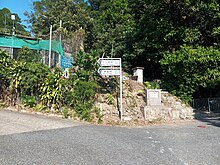Sha Tin Pass



Sha Tin Pass (沙田坳; Cantonese Yale: sā tìhn au) or Shatin Pass, and sometimes Sha Tin Au (沙田凹), is a mountain pass between Temple Hill and Unicorn Ridge in Hong Kong. The pass is located north of the populous area of Tsz Wan Shan, and used to be the only path connecting Kowloon and Sha Tin.[1]
The area is administratively divided along the border between Lion Rock Country Park and Tsz Chuk Pavilion (紫竹亭), with the area inside the mountain belonging to Sha Tin District, and the area under the foothill belonging to Wong Tai Sin District.[2]
History
[edit]Sha Tin Pass was one of major accesses from Kowloon to the south to Sha Tin to the north before the construction of roads and railway. A survey conducted in 1904 recorded 600 persons a day crossing Sha Tin Pass, including 280 of them "carrying goods". A substantial portion of these goods were fresh fish from Tolo Harbour being carried for sale at Kowloon City Market.[3] The British Army built a road in 19th century, Shatin Pass Road from Kowloon to the pass and some villages in Sha Tin District but not to the town of Sha Tin.
Features
[edit]Sheng Kung Hui has a site of Diocesan Youth Retreat House at the pass.
The villages of Mau Tat and Shap Yi Wat are located north of Sha Tin Pass.
The Kwun Yum Temple, Tsz Wan Shan is located in the vicinity of the pass, to its south. It can be accessed via Sha Tin Pass Road.[4]
Access
[edit]Sha Tin Pass can be accessed via Shatin Pass Road.
Stage 4 of Wilson Trail and Stage 5 of MacLehose Trail split at the pass.
References
[edit]- ^ 旅遊網站, UTravel. "沙田坳 - 香港旅遊 | U Travel 旅遊資訊網站". UTravel 旅遊網站 (in Chinese (Hong Kong)). Retrieved 2023-01-17.
- ^ Plan No. DCCA/R/2019/H, Electoral Affairs Commission
- ^ Hase, P.H. (1999). "Beside the Yamen: Nga Tsin Wai Village" (PDF). Journal of the Royal Asiatic Society Hong Kong Branch. 39: 19–20. Retrieved 26 January 2016.
- ^ "Kwun Yum Temple, Tsz Wan Shan". Government of Hong Kong.
22°21′18.94″N 114°11′57.53″E / 22.3552611°N 114.1993139°E
